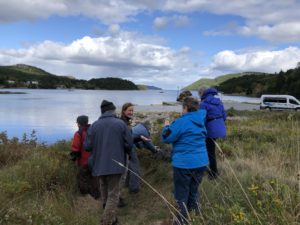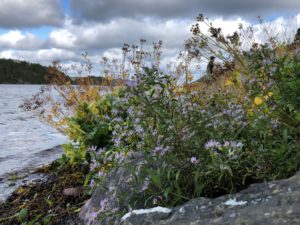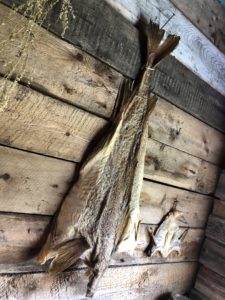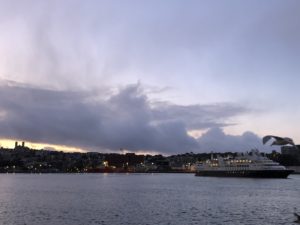We joined our sister in law Lori McCarthy and a small group of tourists on a foraging hike along the shores of Conception Bay. We were gathering edible plants for the menus she’s created for Adventure Canada’s circumnavigation cruise around Newfoundland this week. We ate rose petals and blue berries, mint tips, oyster plant leaves (that really taste like oysters), seaweeds, eel grass, horseshoe crabs, partridge berries, oxbow daisies, lovage, pineapple flowers, and so much more.

“… gathering edible plants…”
It was a truly enlightening experience, but what really shocked us was the realization that we knew almost nothing about it. Lori is a true pioneer in this field, and before she started collecting we actually thought there were no wild edibles in Newfoundland. Aside from the berries and a few dandelion leaves in the spring, we were of the understanding there was nothing “Fit to eat” in the forests. All the mushrooms were poisonous, mint was for “Grass Eaters”, and bees were only here to torment and sting you.
For a land that is nearly completely devoid of soil, and therefore limited agriculture opportunities – why didn’t we avail of this bounty? Here are some thoughts.

“… not fit to eat…”
First, there was nobody here to teach us about the land. Despite several attempts to establish an indigenous community in Newfoundland, every settler, from the Maritime Archaic peoples in 6500 BC to the current breed of “Newfoundlanders”, each was repelled from the island by an ever-changing climate. Nothing so dramatic as what current proponents would call a “Mass Extinction”, more like a gradual retreat from a marginalized environment at a time when our technology could not accommodate even the slightest temperature change. Without any overlap, or interaction between these human tides, little knowledge was ever shared.
The second thing you must understand is that Newfoundland has only experienced one single “mass” migration in all its history. With the end of the Seven Years War and the fall of New France in 1762 – many of the “migratory” fisherman from the Bristol Channel (including Wales) and Waterford, Ireland, decided not to return to their homeland as they usually did each fall.
The religious freedom, vast tracts of lands, and the rich fishing grounds proved so rewarding that by 1830, nearly 30,000 ‘Waterford Migrants’ took up permanent settlement in Newfoundland, establishing fishing operations in every cove, and bay from Cape St. John to Cape Ray on the island’s south west corner.
When this influx ceased, we were left out here in the middle of the Atlantic Ocean, isolated and alone. With few visitors and very limited influence from the outside world, we continue to exist in a virtual time capsule. One that is best described as somewhat paganistic, with all its maddening superstitions, including a bizarre fear of “Faerie’s” and the “Little People” who roamed the woodlands. Don’t suppose you would venture far from the shoreline.
There’s no doubt we were too busy curing fish and rendering seal oils, thus generating so much wealth we could well afford to import any necessary supplies and food staples. As my Miꞌkmaq buddies suggested when asked why they didn’t engage in a gathering culture – “No different than you, we didn’t have to!”

“… too busy curing fish…”
Sickness was something to be avoided at all cost, and gastronomic health is best preserved with consistency of dietary choices. Unproven edibles simply weren’t worth chancing.”
Finally, any behaviour that deviated from the norms established by such a homogenous population would be considered terribly suspect, perhaps even looked upon as a form of witchcraft –something we now understand with all certainty, for this was indeed a magical experience.
Best of luck on your adventures this week – Bon voyage and Bon appetite.


